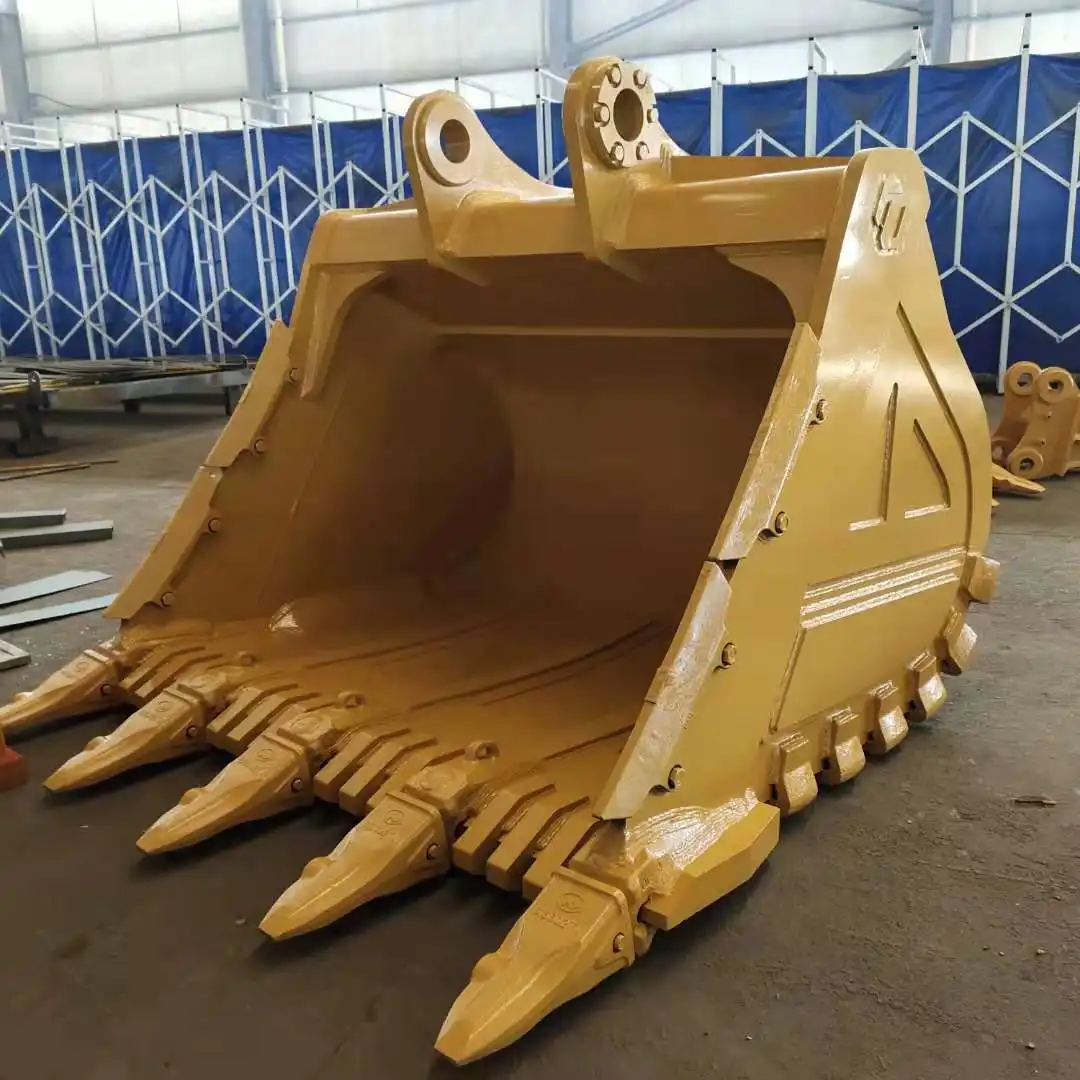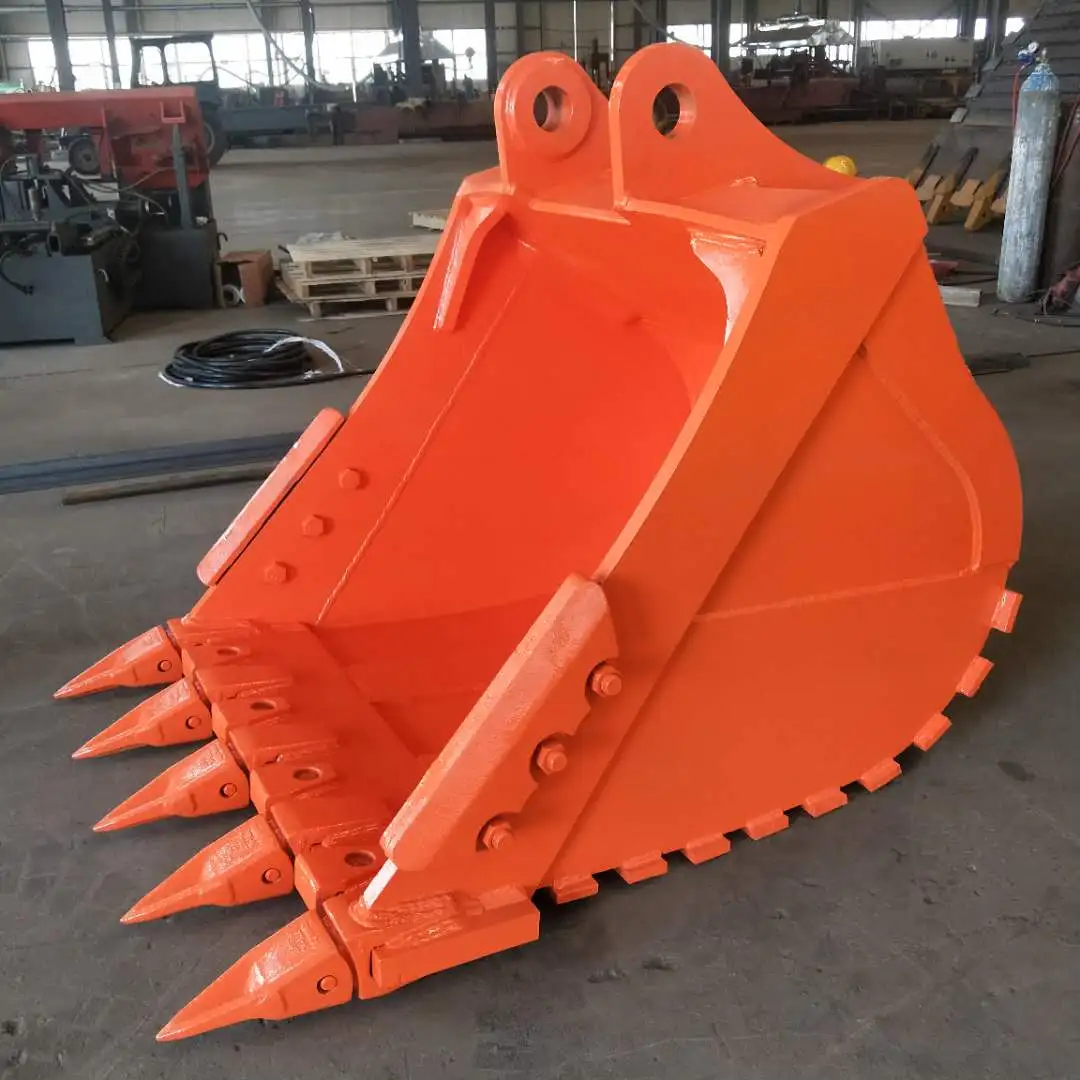What size rock bucket fits my excavator?
Choosing the right excavator rock bucket size is crucial for optimal performance and efficiency. The size that fits your excavator depends on several factors, including the machine's weight, arm length, and intended application. Generally, a rock bucket should be about 10-20% smaller than a standard bucket for the same excavator. For example, a 20-ton excavator might use a 1.0 to 1.2 cubic meter rock bucket. However, it's essential to consult your excavator's specifications and consider the specific job requirements before making a final decision.
Matching Bucket Size to Excavator Capacity
Excavator weight and bucket width correlation
When selecting an excavator rock bucket, the machine's weight plays a crucial role in determining the appropriate size. Heavier excavators can handle larger buckets, while smaller machines require more compact attachments. The correlation between excavator weight and bucket width is not linear but follows a general trend.
For instance, a 5-ton mini excavator typically accommodates a rock bucket width of 24-30 inches (60-75 cm). As you move up to larger machines, the bucket width increases proportionally. A 20-ton excavator might use a rock bucket with a width of 36-48 inches (90-120 cm), while a 30-ton machine could handle buckets up to 60 inches (150 cm) wide.
Calculating optimal rock bucket capacity for your machine
To determine the ideal rock bucket capacity, consider your excavator's lift capacity and the density of the materials you'll be handling. A good rule of thumb is to aim for a bucket that, when full, weighs about 75-80% of your machine's maximum lift capacity at full reach.
Use this formula to calculate the optimal bucket capacity:
Bucket Capacity (m³) = (Machine Lift Capacity (kg) x 0.8) / Material Density (kg/m³)
Remember that rock typically has a higher density than soil or gravel, so your rock bucket capacity will usually be smaller than a standard bucket for the same excavator.
Considering material density in bucket size selection
Material density significantly impacts bucket size selection. Rock, being denser than most other materials, requires a more conservative approach to bucket sizing. Here's a quick reference for common material densities:
- Granite: 2,600-2,800 kg/m³
- Limestone: 2,300-2,700 kg/m³
- Sandstone: 2,000-2,600 kg/m³
- Shale: 2,000-2,400 kg/m³
When dealing with these dense materials, it's crucial to choose a bucket that won't overload your excavator. A smaller, properly sized rock bucket ensures safer operation, reduces wear on your machine, and optimizes fuel efficiency.

Impact of Bucket Size on Performance
How oversized buckets affect excavator stability
Selecting an appropriately sized excavator rock bucket is vital for maintaining excavator stability. Oversized buckets can lead to several issues that compromise both safety and efficiency on the job site. When a bucket is too large for the excavator, it shifts the machine's center of gravity, potentially causing tipping or instability during operation.
This instability is particularly dangerous when working on uneven terrain or slopes. An oversized bucket filled with dense rock material can easily exceed the excavator's rated lift capacity, putting unnecessary strain on the hydraulic system and boom structure. This not only increases the risk of mechanical failure but also significantly reduces the machine's overall lifespan.
Balancing productivity and fuel efficiency with bucket size
Finding the sweet spot between bucket size, productivity, and fuel efficiency is key to optimizing your excavator's performance. While a larger bucket might seem like a shortcut to increased productivity, it often leads to diminishing returns. Oversized buckets require more power to operate, resulting in higher fuel consumption and increased wear on the machine's components.
On the other hand, a properly sized excavator rock bucket allows the excavator to work at its most efficient capacity. It enables quicker cycle times, as the machine can maneuver more easily and doesn't struggle with excessive weight. This balance leads to sustained productivity over longer periods, ultimately resulting in more material moved per gallon of fuel consumed.
Optimizing cycle times with the right rock bucket dimensions
Cycle time – the duration it takes to complete one full excavation cycle – is a critical factor in overall productivity. The right rock bucket dimensions can significantly improve these cycle times. A well-matched bucket allows for smoother operation, quicker fills, and more efficient dumps.
For example, a bucket that's too wide might struggle to penetrate dense rock formations, slowing down the digging process. Conversely, a bucket that's too narrow might require multiple passes to clear an area, increasing cycle times. By choosing a rock bucket with optimal dimensions for your excavator and the specific job requirements, you can achieve faster cycle times and boost overall productivity.

Customization Options for Optimal Fit
TianNuo's tailored rock buckets for various excavator models
TianNuo Machinery offers a wide range of customizable rock buckets designed to fit various excavator models precisely. Their engineering team takes into account the specific make and model of your excavator, ensuring a perfect match in terms of attachment points, hydraulic compatibility, and weight distribution.
TianNuo's excavator rock buckets are available in multiple sizes and configurations, allowing you to choose the optimal solution for your particular needs. Whether you're operating a compact excavator for urban projects or a heavy-duty machine for large-scale quarrying, TianNuo has a rock bucket that can enhance your excavator's performance.
Adapting bucket teeth and wear plates for specific projects
The ability to adapt bucket teeth and wear plates is crucial for maximizing efficiency in different rock-handling scenarios. TianNuo offers various tooth configurations, from standard penetration teeth for softer rock to heavy-duty abrasion-resistant teeth for the toughest materials.
Wear plates can be customized to provide extra protection in high-wear areas, extending the bucket's lifespan and reducing maintenance downtime. For projects involving particularly abrasive materials, TianNuo can incorporate specialized wear-resistant alloys into critical areas of the bucket design.
Innovative designs for enhanced rock handling capabilities
TianNuo's commitment to innovation is evident in their advanced excavator rock bucket designs. Features like optimized bucket profiles for improved material flow and reduced sticky material build-up can significantly enhance productivity. Some models incorporate a spade nose design for better penetration in hard rock formations, while others feature a flat bottom for clean-up operations.
For specialized applications, TianNuo offers rock buckets with integrated ripper teeth or hydraulic thumb attachments, providing versatility in rock handling and sorting tasks. These innovative designs not only improve efficiency but also contribute to reduced fuel consumption and lower operating costs.
Selecting the right size rock bucket for your excavator is a crucial decision that impacts productivity, efficiency, and machine longevity. By carefully considering your excavator's specifications, the material density you're working with, and the specific requirements of your projects, you can make an informed choice. Remember, the ideal rock bucket balances capacity with your machine's capabilities, optimizing performance without compromising stability or fuel efficiency. For the best results, consider customized solutions that take into account your unique operational needs and the challenging nature of rock excavation work.
FAQs
1. How do I know if my current rock bucket is the right size for my excavator?
If your excavator struggles to lift a full bucket, experiences instability during operation, or shows signs of increased fuel consumption, your current rock bucket might be oversized. Conversely, if you find yourself making too many passes to complete a task, your bucket might be undersized.
2. Can I use the same size rock bucket for different types of rock?
While it's possible, it's not always optimal. Different rock types have varying densities and properties. It's best to adjust your bucket size or configuration based on the specific rock you're working with to maintain efficiency and protect your equipment.
3. How often should I replace the teeth on my rock bucket?
The replacement frequency depends on usage and material abrasiveness. Generally, inspect your bucket teeth regularly and replace them when they show significant wear (usually when they've lost about 50% of their original length) to maintain optimal performance.
4. Is it worth investing in a custom rock bucket for my excavator?
Yes, a custom rock bucket can significantly improve your excavator's performance, efficiency, and longevity. The initial investment often pays off through increased productivity, reduced fuel consumption, and lower maintenance costs.
5. How does bucket capacity affect my excavator's fuel consumption?
An oversized bucket can lead to increased fuel consumption as your excavator works harder to handle the extra weight. Conversely, an appropriately sized bucket allows your machine to operate at its most efficient capacity, optimizing fuel usage.
China Excavator Rock Bucket Supplier
TianNuo Machinery stands out as a leading China-based manufacturer of high-quality excavator rock buckets. With a comprehensive range of products including railway maintenance equipment, excavator modification equipment, and various engineering arms, TianNuo caters to diverse industry needs. Their excavator accessories, such as rock buckets, are designed for optimal performance in demanding conditions. For those seeking reliable and efficient rock buckets, you can contact us atboom@stnd-machinery.com. TianNuo's expertise in producing durable, high-performance attachments makes them a trusted choice for construction, mining, and demolition industries worldwide.
References
- Smith, J. (2022). Excavator Bucket Size Selection Guide. Heavy Equipment Journal, 45(3), 78-92.
- TianNuo Machinery. (2023). Rock Bucket Specifications and Performance Data. TianNuo Product Catalog, 7th Edition.
- Johnson, R., & Williams, T. (2021). Optimizing Excavator Performance through Attachment Selection. Construction Equipment Guide, 18(2), 34-49.
- Lee, S., et al. (2023). Impact of Bucket Size on Excavator Efficiency: A Comprehensive Study. Journal of Construction Engineering, 56(4), 312-328.
- Mining Technology Research Group. (2022). Advancements in Rock Bucket Design for Enhanced Durability and Performance. Mining Technology Quarterly, 29(1), 55-70.
- Caterpillar Inc. (2023). Excavator Bucket Selection and Application Guide. Caterpillar Performance Handbook, 53rd Edition, 210-225.
About Author: Arm
Arm is a leading expert in the field of specialized construction and railway maintenance equipment, working at Tiannuo Company.

